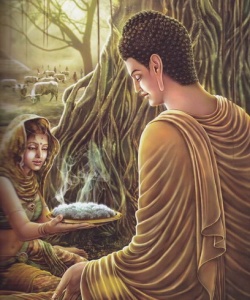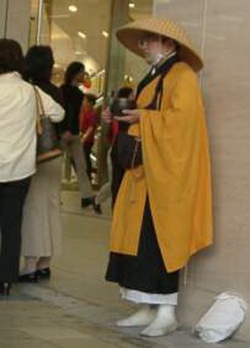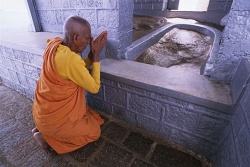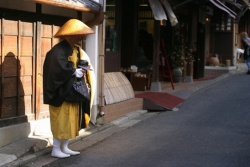Maha Moggallana: Foremost in psychic powers
His youth
Kolita Moggallana was born to the most prominent Brahmanic family of Kolita. He grew up in wealth, educated in the Brahmanic tradition. He was born on the same day as Upatissa (Sariputta) and grew up together. Upatissa was said to be of pioneer character, daring and enterprising, while Kolita was reserved and would cultivate and enrich what he had learned. Kolita was the only child while Upatissa had 6 other siblings.
At an annual hilltop festival, Kolita was disenchanted with the celebrations as he reflected on impermanence. Together with Upatissa, Kolita became an ascetic. Their followers also became ascetics and students of Sanjaya Belatthaputta, one of six non – Buddhist teachers mentioned in the Pali Canon. Unable to find the ultimate truth, they wandered for many years before returning to their home country of Magadha.
This was where Upatissa met Venerable Assaji and became a stream enterer upon listening to a short stanza uttered. Upatissa quickly sought out his friend, Kolita who also became a Stream enterer. They returned to persuade their teacher, Sanjaya to seek out the Buddha at Bamboo Grove Monastery, but he refused.
Struggle for the realization of the teaching.
Both of them were ordained by the Buddha, and Kolita was called Maha-Moggallana, “ the Great One of the Moggallana clan” to distinguish him from other monks of that same clan, such as Ganaka-Moggallana and Gopaka-Moggallana. All the accompanying followers attained stream entry upon listening to Buddha’s dhamma discourse and in due course became Arhants.
Sariputta and Moggallana went into separate solitude. Moggallana chose as his abode the forests near the village of Kallavalaputta in Magadha. While meditating, he became overcome by drowsiness. Buddha appeared before him and advised him in a graded sequence on ways to overcome drowsiness. ( Anguttara Nikaya vii, 58 )
1. Should not give attention to whatever thought that brought about the drowsiness.
2. Should reflect upon Buddha’s teachings, which were heard and learned, examining them closely.
3. Should repeat in full detail the teachings which were heard and learned.
4. Should pull both earlobes and rub limbs with hands.
5. Should get up from seat, washed eyes with water, looked around in all directions, and upwards to the stars and constellations.
6. Should give attention to the perception of light, and cultivate a mind that is full of brightness.
7. Turn senses inward and walk up and down, aware of going to and fro.
8. Mindfully lie down on the right side, placing foot on foot, keeping in mind the thought of rising and wakening; quickly getting up, and not indulging on the comfort of resting and reclining.
If none of the above helped, then he may rest for a short while and gets up after he feels refreshed.
Buddha advised Moggallana on how to avoid excitement and restlessness by not being perturbed on his alms round. Being perturbed, one becomes excited, looses self- control and concentration. Close association with laity can lead to this. Buddha further advised him not to cling onto anything. Moggallana on receiving these personal instructions, strived and became an Arahant on the 7th day after ordination.
One week later after Venerable Sariputta attained Arahantship, they were announced as the Chief disciples of the Buddha. Sariputta was like a mother who delivered the child, bringing the monks into sainthood. Moggallana leads on those who have been saved, guiding them upwards, supporting them in their practice of meditation like the master. They complemented each other as certain questions could be clarified by Sariputta while others only Moggallana could solve.
When Moggallana was ill, the Buddha inspired him with the 7 factors of enlightenment whereby he became well.
Activities of the Chief Disciples
Were directed to maintain stability and discipline within the Order.
They brought about the banishment of the reckless, undisciplined group of 6 monks (chabbaggiya); and returned the misguided monks from Devadatta’s influence back into the Sangha.
Once there was a noisy group of monks that were sent away by the Buddha. Sariputta thought that Buddha wanted to enjoy the bliss of jhana, while Moggallana said that it was their duty to take care and look after them.
Both monks gave many discourses together to their fellow monks e.g. Discourse on Stainlessness, 4 Foundations of Mindfulness, the differences between Sekha and Asekha.
Moggallana’s magical powers
Foremost in magical powers.
There were prominent disciples who had skills in one or the other of magical powers,e.g. Anuruddha and the nun Sakula possess the Divine Eye; Sobhita and nun Bhadda Kapilani could recollect far into the past, Cula Panthaka was skilled in astral travel and Pilinda excelled in communication with heavenly beings. Maha Moggallana was the master of all magical faculties.
1. Penetration of others’ minds and thought reading (telepathy). On an uposatha day, Buddha noted that the assembly was impure. Moggallana then surveyed the minds of entire assembly and asked the corrupted monk to leave.
2. Divine Ear. Moggallana was able to converse with the Buddha in Savatthi while he was in Rajagaha due to Divine Ear and eye. He could also hear voices of non human beings like deities and receive messages from them. A deity had warned him of Devadatta’s evil intentions towards the Buddha.
3. Divine Eye. Moggallana could perceive Buddha from a faraway distance. He could also see the mischievous demon that hit Sariputta while he was meditating. He could see the operation of law of Kamma and its fruits. Evildoers were reborn in woeful states while those who were virtuous went to the heavenly realms.
4. Astral travel by mind-made body. Moggallana was able to appear in the heavenly realms and teach the heavenly beings, e.g. Gods of the 33, Brahma.
5. Telekinesis (supernormal locomotion). He was able to shake the entire building with his big toe in order to teach the negligent monks staying in the monastery or even Sakka’s palace when the latter was lax in his practice.
Moggallana did not display his psychic powers for impressing laity unlike Pindola who was chided by the Buddha when he brought down a bowl hung high up in the air.
Buddha also confirmed that Moggallana was a very capable speaker on Dhamma, especially from one with a depth of experience.
Death of Moggallana
Moggallana passed away 2 weeks after Sariputta. Both of them were 84 when they passed away.
After the death of the leader of the Jains, there was a loss of devotees and support. The Jains had learned that Moggallana reported from his celestial travels that the virtuous devotees of the Buddha had heavenly rebirth while followers of other sects who lacked moral conduct had fallen into woeful states. The lowest type of Jains in Magadha were so enraged about the loss of public esteem and support that they wanted to get rid of Moggallana. Hesitating to kill him themselves, they had hired killers to do the murder.
Moggallana could absent himself for 6 days when the killers came as he hoped to save the killers from rebirth in hell. On the 7th day, Moggallana knew that he could not escape the nature of his death due to a previous misdeed done in a previous life. The killers assaulted him and left him for dead in a pool of blood. With his great physical and mental strength; he dragged himself to the Buddha and passed into mahaparinibbana in his presence. This last episode of Moggallana’s life showed the law of moral causality was even greater than his mastery over magic.



